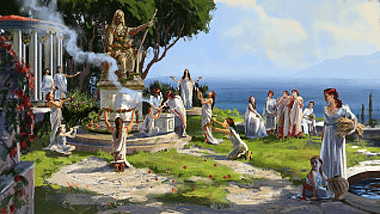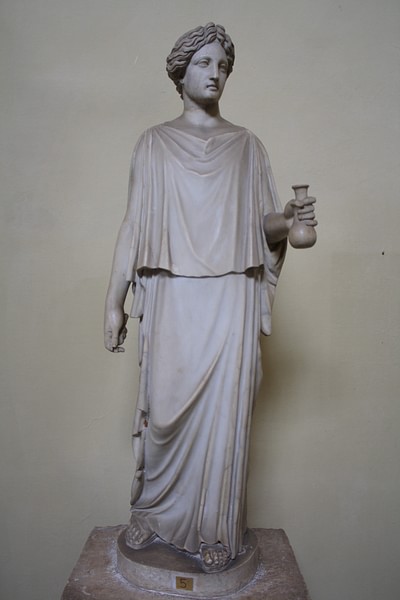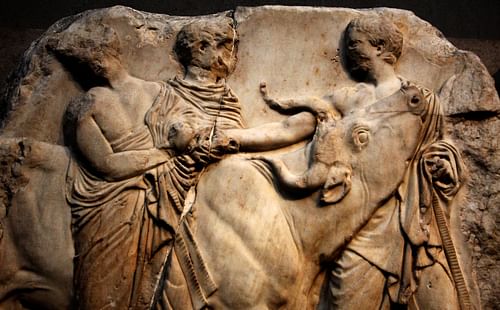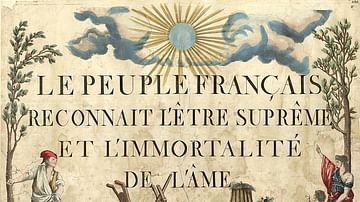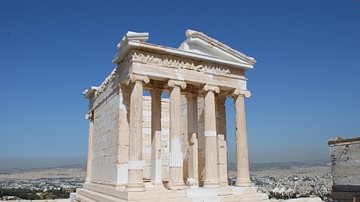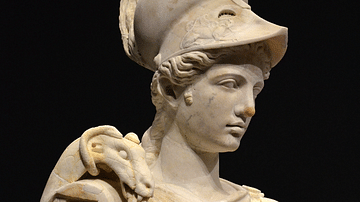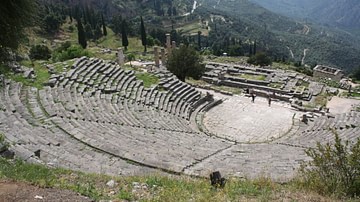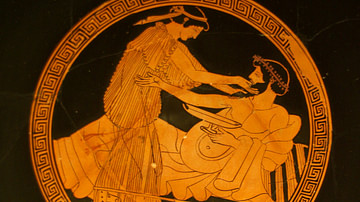In ancient Athens, women had no life outside the home unless they were prostitutes or were engaged in religious activities such as festivals. Every Greek deity in every city-state had their own cult (sect) but the cult of Athena offered women positions of power and autonomy in a city-state that regularly denied them both.
Other Greek cities, notably Sparta, allowed women far greater freedoms than Athens. Spartan women managed estates, could inherit and own property, and were educated. Athenian women could hold land in trust for a male, managed the household, spun wool, and education for them was considered a waste of time because they would never be given an opportunity to use it.
The cult of Athena, however, allowed women to fully participate in the life of the city from the time they were young girls. Some women continued on as Athena’s clergy while others left active service once they got married but, either way, they continued to participate in the festivals honoring the goddess and were able to enjoy positions of respect and considerable power.
Athena
In Greek mythology, Athena is the goddess of wisdom, war, household crafts, and cooking who was known by many epithets including Athena Polias ("of the city"), Athena Nike ("of victory"), Athena Ergane ("the industrious") and Athena Promachos ("who fights in front") as well as others. She may have developed from the earlier Mesopotamian goddess Inanna (also a warrior goddess and better known as Ishtar) but, according to the ancient Greek myth regarding her birth, she sprung fully grown from the forehead of her father Zeus, king of the gods. Athena was Zeus’ favorite daughter and among the most popular with mortals throughout Greece. There were shrines and temples dedicated to Athena in many city-states, not just in Athens, as she epitomized a number of the central values of Greek culture: skill in warfare, wisdom in one’s business, martial, and personal affairs, courage, independence, and female virginity.
Athena was a devout virgin and one of her epithets was Athena Parthenos ("the virgin" which is how the Parthenon, her most famous temple, got its name). She was also known as Pallas Athena ("she who brandishes weapons") and was able to defend herself against male aggression. In one story, Athena goes to Hephaestus, the god of the forge, to ask him to make her some weaponry. Overwhelmed by her beauty, Hephaestus tries to rape her, but she fights him off. During their struggle, a drop of his semen falls on her thigh which she quickly wiped away and flung onto the fertile earth, thereby giving birth to Erichthonius, a legendary king of Athens, while remaining a virgin. Erichthonius is the mythical founder of the Panathenaic Festival and, owing to a later myth, associates Athena with the serpent.
Although her best-known totemic animal is the owl (signifying wisdom) she is also associated with the snake (a symbol of transformation) which guarded Erichthonius when he was an infant enclosed in a casket. The colossal statue of Athena which once stood in the Parthenon included the serpent which was thought to protect the city. The travel writer Pausanias (l. 2nd century CE) describes the statue:
The cult statue is made of ivory and gold. In the middle of its helmet is a sphinx and on either side of the helmet are carved griffins. The statue of Athena stands upright in an ankle-length robe, and on its breast is an ivory representation of the Gorgon Medusa. Athena holds in one of her hands a Victory [the goddess of victory, Nike], about four cubits tall, and in the other a spear. At her feet lies a shield and, by the spear, a snake which might be Erichthonius. (Greece, 1.24.5-7; Athens,Waterfield, 95)
Erichthonius, as a serpent, became the protector of Athena’s temple on the Acropolis and, by extension, of Athens. He was thought to be a living entity who, though unseen, was still a potent force guarding his virginal mother’s city.
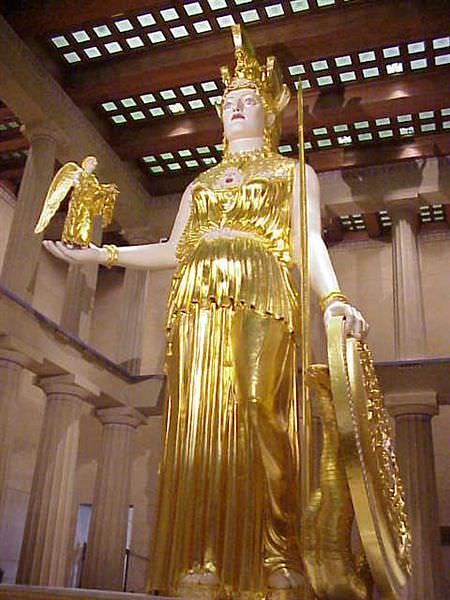
According to legend, she came to be associated with Athens after winning a competition with Poseidon, god of the sea. She and Poseidon both wanted to become the patron deity of the city and so offered the people gifts. Poseidon struck the rock of the Acropolis with his trident and brought forth fresh, cool water, but Athena presented the people with the olive tree which they recognized would be more valuable. Interestingly, in one version of this myth, it is the women of the city who understand the value of the olive tree and vote for Athena as the city’s patron. The giving of gifts and hospitality were highly valued in ancient Greece, and Athena was famous for both.
She was the patron goddess of a number of famous heroes whom she helped achieve their goals, among them Jason and the Argonauts, Heracles, Orestes, and Diomedes, one of the heroes of the Trojan War. In the Iliad of Homer (8th century BCE), which made that conflict famous, she also helps Achilles defeat Hector, and in the Odyssey, she is the central figure to assist Odysseus once he finally reaches his home on Ithaca. In all these tales, Athena is depicted as a powerful woman men listen to and learn from, enabling them to succeed. She exemplified military prowess, the martial ideal, and was also respected as a goddess of counsel. She was understood this way in Athens as elsewhere but, for whatever reasons, the men of Athens did not see the goddess reflected in the women of the city who lived as second-class citizens.
Women in Ancient Athens
Athenian women were relegated to their own quarters inside the home, which could be locked from the outside, and were expected to marry, bear children, raise the children, keep the home, and do so as quietly as possible. Although there are records of lower-class women who were potters, craftspeople, and merchants, and of upper-class women who worked as courtesans (hetaira), women who appeared outside of the home were largely female slaves, prostitutes, or metics (foreigners). Female, as well as male, prostitutes were a regular feature of the streets and alleys of Athens, but not maidens, wives, or mothers who were kept at home and under the control of a male guardian, either a father, a husband, an adult son, or another male relative. Scholar Louise Bruit Zaidman comments:
Athens, of course, was not all of Greece. As far as the place of women is concerned, the situation there was unusual, even extreme. Distrust of women, misogyny in rhetoric and law, were greater in Athens than anywhere else. Indeed, Athenian misogyny was so extreme that a myth was needed to explain why women there were not to be called Athenians and children were not to take their mother’s name. Varro tells us that it was to quell Poseidon’s ire, aroused when the women of Athens voted to name the city after Athena rather than himself. According to the Periclean law of citizenship (451 BCE), citizenship was granted to any man who could prove he was the son of both a citizen and “the daughter of a citizen”. When a boy was registered [at birth] the name of his mother’s father was recorded but not that of his mother. If the father swore that the son was the product of a marriage with a “woman of the city” the mother’s name was not mentioned. (Schmitt Pantel, et. al. 339-340)
The patriarchy of Athens defined the role of women in society as child bearers, and it was understood that this was all that a woman needed to be fulfilled. Marital sex was for procreation; pleasurable sex for men was extramarital with younger men, male or female prostitutes, or hetairai. Scholars continue to debate whether women were even allowed to attend the Greek theater and, if they were, they were segregated from the men. It was only in the religious sphere that women could share equally in the life of the city and, in Athena’s cult, enjoy positions of respect and authority. Zaidman notes:
Of the thirty festivals celebrated in Athens each year, many of which continued for two or three days, women participated actively in nearly half. Different celebrations involved different aspects of women’s lives. Young girls carried baskets of offerings to Athena in the Arrephoria and Plynteria; married women took part in the Haloa and Thesmophoria of Demeter; women of a canonical age waited on the queen of the Anthesteria, over which Dionysius presided. The culmination was the Panathenaea (celebrated every year and with greater pomp every fourth year), in which women of all ages and conditions took part. (340)
Even though, for the greater part of the time, women were expected to remain at home, quietly spinning wool, making garments, and tending to the house and children, religious festivals gave them an opportunity to emulate the goddess in courage and independence and especially so as active members in the cult of Athena.
The Women of Athena’s Cult
Between birth and the age of seven, girls and boys were raised by their mothers more or less the same, but after seven, boys were taken in hand by their fathers to learn his trade and become Athenian citizens while girls were prepared for marriage, motherhood, and housekeeping. This, as far as the records indicate, was how the upper class of Athens operated, but it is assumed that all classes followed roughly the same paradigm as the upper class set the model for how the lower class would live.
Among the aristocratic upper class, between the ages of seven and eleven, the male assembly of Athens would choose four girls, known as arrephoroi ("sacred basket bearers"), for a special honor. Two of them would participate in weaving the large peplos (garment) which would be offered as a gift to Athena and would clothe her famous statue in the Parthenon. The other two would participate in a ritual during which they carried sealed caskets, which they were forbidden to look into, on their heads to a certain spot in the gardens below the Acropolis and exchange whatever was in them for other objects placed in the caskets which were then either carried up to the Acropolis or returned to their source.
This ritual reenacted the story of Erichthonius who, as an infant, was placed in a small casket by Athena to keep him safe and keep his birth a secret. She gave the casket to the three daughters of King Cecrops of Athens for safekeeping, charging them to never look inside. One of the girls, Pandrosus, heeded the warning, but the other two, Herse and Aglaurus, could not contain their curiosity and peeked into the casket. There they saw either the infant Erichthonius wrapped in the coils of a snake or the half-infant-half-serpent that was Erichthonius. The girls were so horrified by the sight that they went mad and hurled themselves off the top of the Acropolis to their deaths. In the reenactment, the young virgins selected to carry the caskets redeemed the sin of the daughters of Cecrops by not looking into the caskets and delivering them faithfully to their destination.
Girls between, roughly, the age of 11-14 were honored as kanephoroi who carried a basket (kanoun) of sacred barley to be placed on the altar of blood sacrifices of animals. Women were not allowed to participate in blood sacrifice in Athens and so this was an enviable position among the maidens of the city. Scholar Sarah B. Pomeroy comments:
The kanephoroi were virgins selected from noble families. Their virginity was a potent factor in securing the propitious use of the sacred offerings and sacrificial instruments carried in their baskets. To prevent a candidate from participating in this event was to cast aspersions on her reputation. (75-76)
The most famous example of how serious the rejection of a candidate could be is the 514 BCE rebuff of the sister of Harmodius. At this time, Athens was ruled by the two sons of Peisistratus (d. c. 528 BCE), Hippias (r. c. 528-510 BCE) and Hipparchus (r. c. 528-514 BCE). Hipparchus propositioned a young man named Harmodius who already had a lover, Aristogeiton, and was rejected. In response, Hipparchus dismissed Harmodius’ sister as a kanephoroi without explanation, thereby questioning her virtue and insulting the family name. Harmodius and his lover Aristogeiton assassinated Hipparchus during the Panathenaic Festival of 514 BCE which caused Hippias to become more tyrannical and, in 510 BCE, led to his fall and the restoration and development of Athenian democracy.
The kanephoroi might continue to serve the goddess through their early teens until they were married. Women could be chosen, based on family connections or notable virtue, as hiereiai, high priestesses, who might serve only until they were married, serve for only one year, or might serve for life. The high priestess of Athena was among the most prestigious positions in Athens, and the woman who held it was thought to convey to the people the will of the goddess. When the Persians invaded Greece in 480 BCE, according to Herodotus, the high priestess of Athens had the people evacuate the city just prior to the Battle of Salamis by telling them that the serpent Erichthonius, and therefore Athena, had already fled the Acropolis and they should follow suit (Histories, VIII, 41). The Athenians listened to her warning and evacuated the women and children and various goods before the men returned to defend the city.
Conclusion
Women participated in the Rites of Demeter, the Eleusinian Mysteries, freely with men and, as noted, in many other Athenian festivals but the women who actively participated in Athena’s cult, even after they were married and relegated to the women’s quarters of the home, continued to contribute and were recognized and honored. The peplos which was begun by the girls selected in their youth was continued and completed by those who had performed the same role when they were young. The gigantic peplos was carried, every four years, by the women who had created it up the Panathenaic Way to the Acropolis during the Greater Panathenaic Festival.
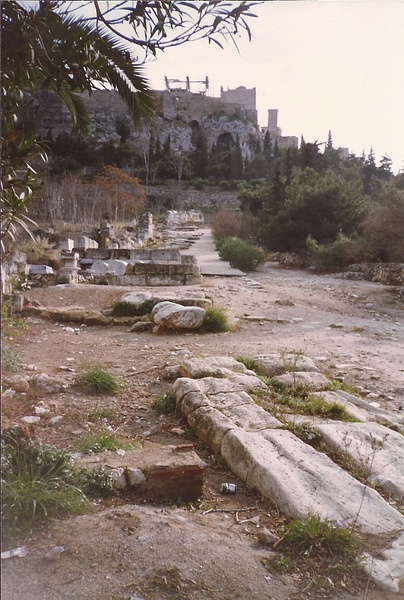
The cult of Athena provided women in ancient Greece not only with a purpose outside the home and childbearing but a significant role in the life of the city. In the Athenian culture, which regularly suppressed feminine energy, even while celebrating it through their patron deity, Athena’s cult was an opportunity for women to express themselves, be recognized, and contribute to the religious and cultural life of the city. The cult continued until sometime in the 4th century CE when, after the rise of Christianity in Greece, it lost adherents as women became Christians.
Christianity, at first, encouraged women’s participation at all levels and allowed the same kind of freedom and personal recognition they had derived from Athena’s cult. At the Council of Nicaea in 325 CE, however, which sought to unify the Christian vision and standardize its practice, the men chose to follow the earlier lead of Pope Clement I (l. c. 35-99 CE) who had decreed that only men could hold positions of authority in Christianity because Christ had only chosen male apostles. The decision at Nicaea relegated women to secondary status in the new religion and, with the waning of the cult of Athena - as well as those of other powerful female deities who had also provided opportunity for social elevation - the women of Athens again assumed the only role allowed them by the men of the city as child-bearers and homemakers.
